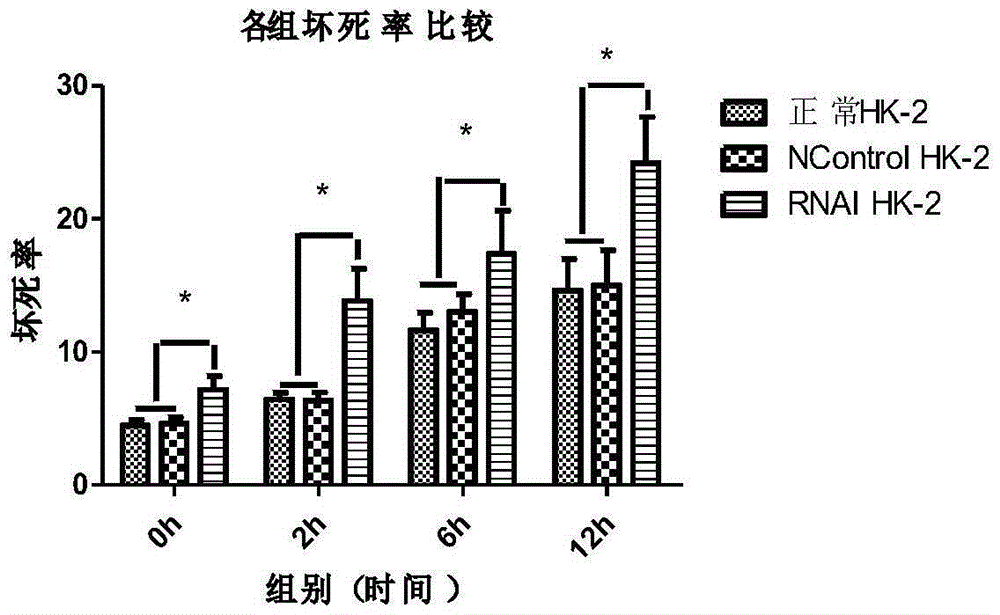Application of TRPC6 in preparation of medicament for diagnosing and treating kidney ischemic reperfusion injury
A technology of renal ischemia reperfusion and medicine, applied in the field of biomedicine
- Summary
- Abstract
- Description
- Claims
- Application Information
AI Technical Summary
Problems solved by technology
Method used
Image
Examples
Embodiment 1
[0030] Example 1 Bioinformatics Analysis of the Molecular Mechanism of Renal Ischemia-Reperfusion Injury Based on Gene Chips
[0031] 1.1 Research materials
[0032] 1.1.1 Experimental animals
[0033] 6-week-old SD and BN rats weighing between 180-230 g were fed in the clean animal feeding room of the Experimental Animal Center of Southwest Hospital of Third Military Medical University. All rats were provided by the Experimental Animal Center of Daping Hospital, Third Military Medical University.
[0034] The animal room was kept clean, the indoor temperature was controlled by an air conditioner between 23°C and 28°C, the indoor humidity was controlled between 40% and 70%, and a 12h day and night cycle was maintained indoors. Animals had free access to food and water, and were observed daily and their body weight monitored.
[0035] 1.2 Research Methods
[0036] 1.2.1 Grouping of experimental animals
[0037] We selected GSE9943 in the NCBIGEO database, and there were 12...
Embodiment 2
[0054] Example 2 The role and mechanism of TRPC6 in regulating the programmed necrosis of human renal tubular epithelial cells in vitro ischemia-reperfusion injury
[0055] 2.1 Research materials
[0056] 2.1.1 Experimental cells
[0057] The human renal tubular epithelial cell line (HK-2) was preserved by the Kunming Cell Bank of the Chinese Academy of Sciences.
[0058] 2.2 Research Methods
[0059] 2.2.1 Immunofluorescence detection of TRPC6 expression on HK-2 cells
[0060] The HK-2 cells were subcultured into a special culture dish for laser confocal, and the old culture medium was discarded after continuing to culture for 24 hours. After washing with PBS, they were fixed with pre-cooled 4% paraformaldehyde at 4°C for 20 minutes. After washing with PBS for 3 times, 1% Triton-X100 was added to permeabilize for 10 min, and then washed with PBS for 3 times and then blocked with 1% BSA for 20 min. Then add rabbit anti-human TRPC6 polyclonal antibody diluted 1:50, overnigh...
Embodiment 3
[0146] Example 3 Experimental study on the protective effect and mechanism of TRPC6 regulating programmed necrosis on rat renal ischemia-reperfusion injury
[0147] 3.1 Research materials
[0148] 3.1.1 Experimental animals
[0149] SD rats are experimental animals described in Example 1.
[0150] 3.2 Research Methods
[0151] 3.2.1 Grouping of experimental animals
[0152] According to the principle of random block design, they were divided into: (1) blank control group (Control): without any treatment; (2) sham operation group (Sham): in the experiment, only the renal artery was separated after anesthesia to expose the renal pedicle without cutting The abdomen was closed after the renal artery was not clamped; (3) Ischemia-reperfusion group: the left kidney of the rat was excised after anesthesia, the right renal pedicle of the rat was separated, and the perfusion was restored after clamping with a non-destructive arterial clip for 40 minutes; (4) Ischemia-reperfusion+OA...
PUM
 Login to View More
Login to View More Abstract
Description
Claims
Application Information
 Login to View More
Login to View More - R&D
- Intellectual Property
- Life Sciences
- Materials
- Tech Scout
- Unparalleled Data Quality
- Higher Quality Content
- 60% Fewer Hallucinations
Browse by: Latest US Patents, China's latest patents, Technical Efficacy Thesaurus, Application Domain, Technology Topic, Popular Technical Reports.
© 2025 PatSnap. All rights reserved.Legal|Privacy policy|Modern Slavery Act Transparency Statement|Sitemap|About US| Contact US: help@patsnap.com



